ここから本文です。
Welcome to Nanao Castle
この英語解説文は観光庁の地域観光資源の多言語解説整備支援事業で作成しました。
This English language text was created by the Japan Tourism Agency.
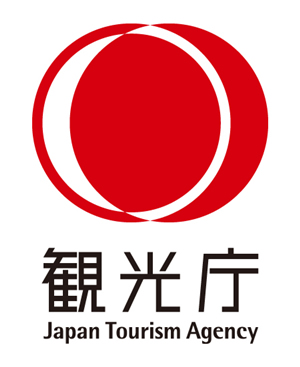
Nanao Castle Site
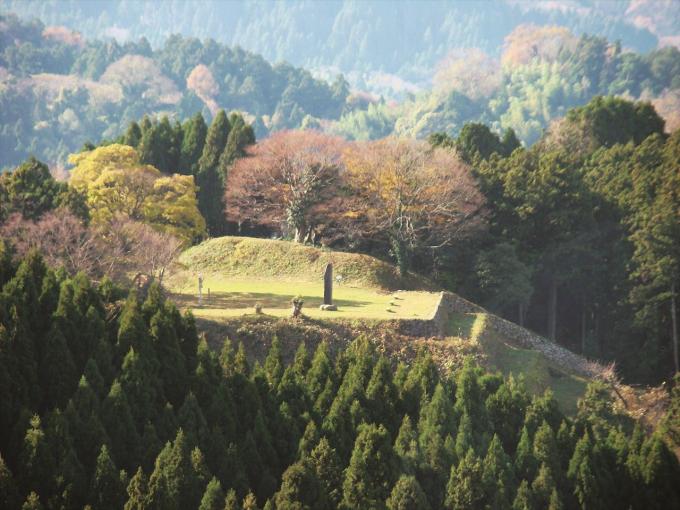
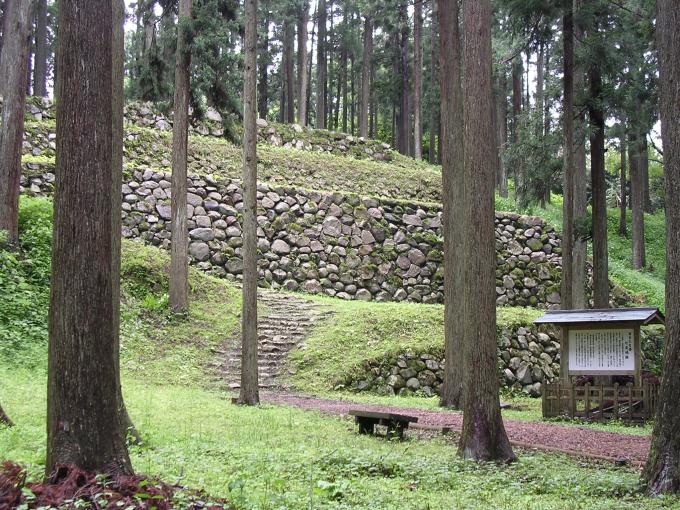
Nanao Castle was considered impenetrable when it was built in the early sixteenth century. It was the home fortress of the Noto branch of the Hatakeyama family, who governed the Noto Peninsula from the late fourteenth to sixteenth centuries. The castle and defensive works were built in the first half of the sixteenth century, though the exact dates are unknown. It encompassed the upper reaches of Mt. Jo (300 m), stretching 2.5 kilometers north to south and 1 kilometer east to west.
A complex power dynamic
Remains of an impressive fortress
A castle city under siege
A castle abandoned
Uesugi Kenshin took possession of the castle, but he died the following spring. After Kenshin’s death, Oda Nobunaga took control of the Noto Peninsula and Nanao Castle, which he awarded to his general Maeda Toshiie (1538–1599) in 1581. Toshiie further fortified the castle but made his home closer to Nanao Port, which was more convenient for transport and governance. The castle was abandoned in 1589, but some of the fortification walls Toshiie added remain.
There is a parking area a short walk from the steps to the Honmaru. Visitors can also walk to the main keep from the base of the mountain. The route starts near the Nanao Castle History Museum and takes about one hour.
The Hatakeyama Family and the Siege of Nanao Castle
Infighting and betrayals plagued the history of the Noto branch of the Hatakeyama family. The family was originally from Kyoto and governed the Noto Province (modern-day Noto Peninsula) from 1391 until Nanao Castle fell in 1577. Over the course of their rule, Hatakeyama control was challenged by their retainers, and they eventually lost their grip on power. Power struggles and conflicting allegiances among the retainers culminated in the formation of a council of seven, and ultimately led to the fall of Nanao Castle and the end of Hatakeyama family rule of Noto.
Building a mountain fortress
Hatakeyama Yoshifusa (1491–1545) became the seventh head of the Noto-Hatakeyama family in 1515, and Noto flourished under his rule. Yoshifusa succeeded in quelling dissent within the Hatakeyama family and built up its military forces. He constructed Nanao Castle as his principal residence, invited scholars from Kyoto to visit and lecture, and encouraged artisans and merchants to move to Nanao, creating a thriving town at the base of the castle. Yoshifusa also controlled the shipping trade in Nanao Bay and Toyama Bay and contributed to the development of the Hodatsu gold mine south of Nanao. Nanao and the Hatakeyama family enjoyed significant prosperity and stability under Yoshifusa’s rule, until his death at age 55.
An uneasy alliance
Hatakeyama Yoshitaka (1556–1576) was the eleventh head of the Noto-Hatakeyama family, coming to power after the sudden death in 1574 of his elder brother. There is speculation that his elder brother was assassinated by a retainer. Yoshitaka was still a teenager when he was installed as the new head of the family, and a council of seven senior retainers held the real power.
From the mid-sixteenth century, the Hatakeyama family governed Noto Province with their senior retainers including the Yusa family and Cho family, who had large walled compounds within the castle grounds. These families were constantly jockeying for power, creating an uneasy alliance. Yusa Tsugumitsu (d. 1581) was a general from the Suzu area of Noto Province who rose to lead the group of seven senior retainers. Outside of the Hatakeyama family, Tsugumitsu’s loyalties lay with the Uesugi Kenshin (1530–1578), a powerful warlord leader from Echigo Province (modern-day Niigata Prefecture). Uesugi Kenshin opposed Oda Nobunaga (1534–1582) who, after defeating the ruling Ashikaga shogunate in 1573, was on a campaign to unite Japan under his rule. While Tsugumitsu supported the Uesugi, his brother-in-law, senior vassal Cho Tsugutsura (–1577) supported Oda Nobunaga, and a power struggle ensued.
A family under siege
In the late sixteenth century, two powerful warlords dominated the country, conquering the territories in their path. To the west was Oda Nobunaga and to the east was Uesugi Kenshin. It was not clear which side the Hatakeyama family supported, as the family was essentially under the control of retainers of rival allegiances. Uesugi Kenshin decided to attack Nanao Castle in 1576 with around 20,000 troops, laying siege for two months, but failing to breach the castle.
Within the castle walls, an epidemic broke out, and the eleventh lord Hatakeyama Yoshitaka died, at age 20. His young son Hatakeyama Haruomaru (1572–1577) was installed as the new leader, though the real authority was held by Cho Tsugutsura, who had risen to the position of head retainer. Uesugi Kenshin returned in 1577 in a second attempt to capture Nanao Castle. The castle held out under siege for almost a year, while Tsugutsura sent a request to Oda Nobunaga for help.
The enemy within
Cho Tsugutsura compelled the residents of Nanao to join the Hatakeyama family garrison to defend the castle, but an epidemic weakened the defenders. Even the infant Haruomaru succumbed and died. It is believed that on September 15, 1577, Yusa Tsugumitsu and his allies staged a revolt within the castle, killing Cho Tsugutsura and many of his family, and opening the castle gates to Uesugi Kenshin and his forces. The fragile rule of the Hatakeyama family came to an end.
Uesugi Kenshin gave control of the castle and the province of Noto to Yusa Tsugumitsu. The following year, Uesugi Kenshin died suddenly (likely from ill health), and Oda Nobunaga invaded Noto. It is said that Tsugumitsu and his son surrendered to Nobunaga but were executed for their part in orchestrating the assassination of the Cho family.
Nanao Castle History Museum
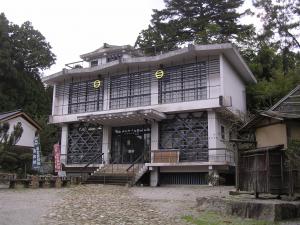
Nanao Castle was one of the great mountain castles of Japan and was considered almost impregnable until it fell to the forces of warlord Uesugi Kenshin (1530–1578) in 1577. The castle was built in the early sixteenth century by the Hatakeyama family who ruled the Noto Peninsula for 186 years from the fifteenth to sixteenth centuries.
The museum at the base of the mountain below the castle site displays artifacts excavated from the grounds of the former fortress. The building features the Hatakeyama family crest, two horizontal lines within a circle, as a decorative element on the facade. The museum has two floors, and on the first, a large screen shows a computer graphic presentation of the castle as it may have looked in the sixteenth century. Visitors can watch the presentation in English or Japanese. The video gives visitors a better understanding of the vast scale of the castle, which resembled a city covering several ridges of the mountain.
A large illustration depicts the town at the base of the mountain as it would have looked in 1544 when the Hatakeyama family was at the height of its power. The detailed image, based on archaeological finds, gives insight into the life of ordinary townspeople in the sixteenth century. On the second floor of the museum, the displayed artifacts include pottery, lacquerware, and crafts dating from the fourteenth to sixteenth centuries.
The Nanao Castle History Museum is open from 9:00 a.m. to 5:00 p.m. (Closed on Mondays.)
Kaikokan Historic House
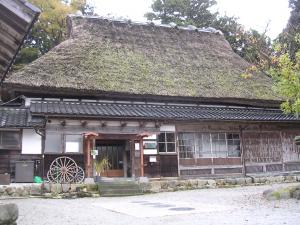
A large, traditional house with a mossy thatched roof stands in a clearing at the base of Mt. Jo, on the approach to the site of Nanao Castle. The house was built in 1820 for the Iida family, which served as village officials and stewards of the Kaga domain (present-day Ishikawa Prefecture).
The house is open to the public as a folk museum. It is a well-preserved example of a wealthy farming family home from the nineteenth century. Original structural features include the thatched irimoya-zukuri hip-and-gable roof and an irori sunken hearth, and artworks and household goods belonging to the Iida family are on display. A large, landscaped garden surrounds the house, with a well and moss-covered garden stones.
Visitors to the house can enter the main living area from the earthen-floored entrance. The room centers on a sunken hearth, where the family would gather to eat and relax. A hook is suspended above the hearth for hanging a cooking pot. The walls are lined with decorative folding screens. The transoms of the adjoining room, which has the household Buddhist altar (butsudan), have panels carved to depict famous landscapes.
The rooms toward the back of the house overlook the garden and were used for formal entertaining. A large painting depicts the powerful daimyo Uesugi Kenshin (1530–1578), who captured Nanao Castle in 1577. He sits surrounded by his generals, composing a poem after the main keep of the castle has fallen to his forces.
The Kaikokan Historic House is open daily from 9:00 a.m. to 5:00 p.m. (Closed on Mondays and during winter from mid-December to mid-March.)
Nanao Mt. Jo Observation Platform
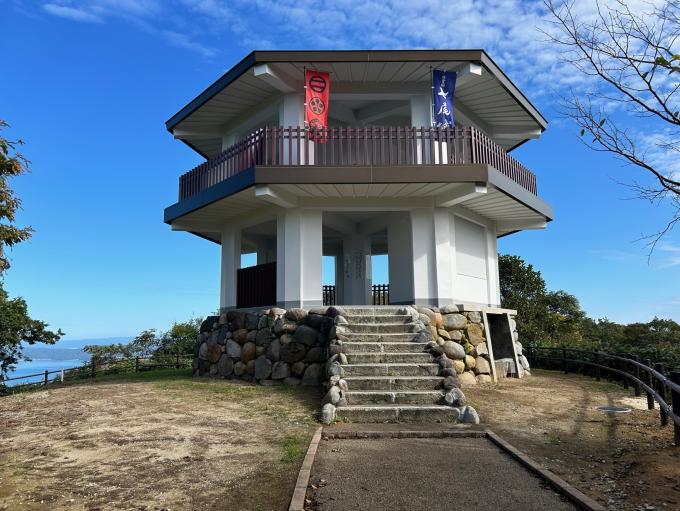
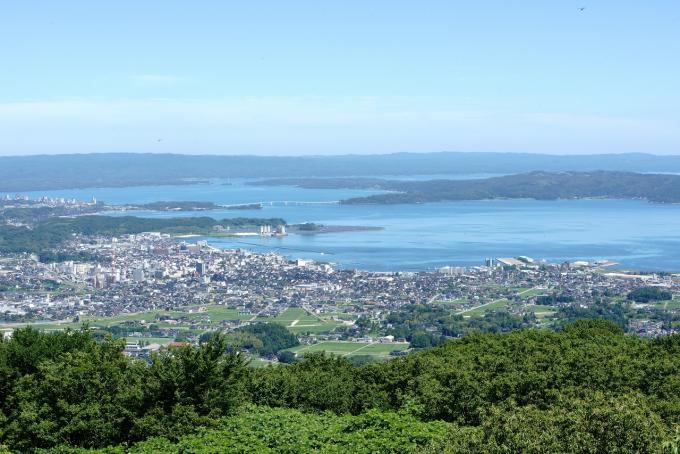
Near the top of Mt. Jo in Nanao, a two-story observation platform commands views of the Noto Peninsula, with the site of Nanao Castle to the west, Nanao Bay and Noto Island to the north, and Toyama Bay to the east. The seven-sided observatory is built around a central pillar. Each side faces one of the seven mountain ridges from which Nanao (nana means seven), derives its name. The observation deck is 380 meters above sea level and affords a magnificent view of the nearby Nanao Castle site.
On the second floor, a large panoramic photograph indicates the positions of major landmarks in the distance. Signs in Japanese around the central pillar tell the story of Nanao Castle and the Hatakeyama family who ruled the Noto Peninsula in the fifteenth and sixteenth centuries. There are explanatory signs about the castle and the family in English along the road between the entrance to the castle site and the observation platform.
The observation platform is about 700 meters from the castle site, along a narrow, winding road. There is a car park with toilet facilities and a small park next to the observation deck. In spring, cherry blossoms bloom in the park. Entrance to the castle site and the observation platform is free and open 24 hours a day.
